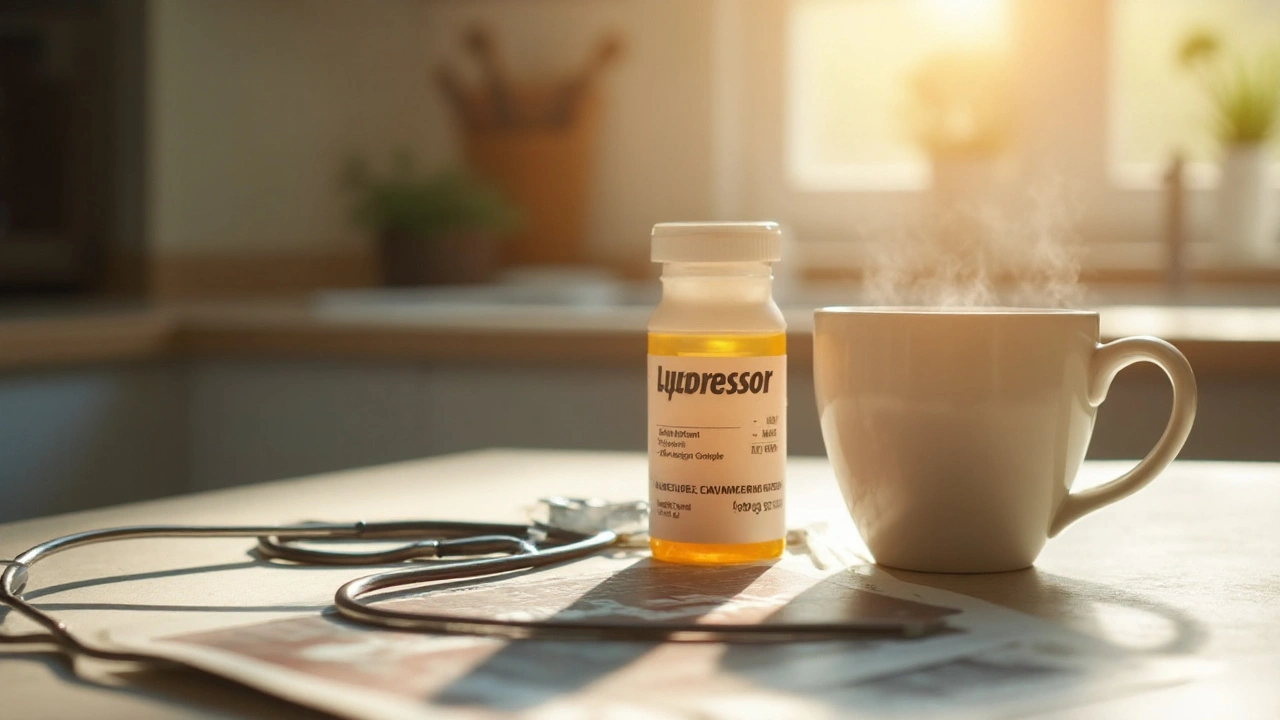TL;DR:
- Lopressor is the brand name for metoprolol tartrate, a beta‑blocker used mainly for high blood pressure, angina and certain heart rhythm problems.
- Typical adult dose starts at 50‑100mg twice daily; doctors adjust based on response and health status.
- Common side effects include fatigue, dizziness, cold hands/feet and mild depression; serious reactions are rare but need medical attention.
- Take it with food or water, at the same times each day; never stop abruptly without consulting a doctor.
- Check for interactions with asthma meds, certain antidepressants and other heart drugs; ask your pharmacist if unsure.
What is Lopressor?
Lopressor is the trade name for metoprolol tartrate, a selective beta‑1 adrenergic blocker. In plain language, it slows the heart’s “engine” by blocking adrenaline‑like signals. The result is lower heart rate, reduced blood pressure, and less strain on the heart muscle. It’s been on the market since the early 1990s and is prescribed worldwide for conditions such as hypertension, angina (chest pain), and certain types of arrhythmias.
The drug comes in immediate‑release tablets that most people take two or three times a day. There’s a longer‑acting version called metoprolol succinate (brand name Toprol‑XL), but Lopressor refers specifically to the tartrate formulation.
How It Works & Who Should Take It
Beta‑blockers like Lopressor target the beta‑1 receptors found mainly in the heart. By occupying these receptors, metoprolol reduces the heart’s response to stress hormones (epinephrine and norepinephrine). The practical upshot is a slower, steadier heartbeat and less forceful contractions, which translates into lower blood pressure.
Typical candidates include:
- Adults with newly diagnosed or uncontrolled hypertension.
- People who experience angina during exertion.
- Patients with atrial fibrillation who need rate control.
- Those recovering from a heart attack (post‑MI) to improve survival odds.
Doctors usually avoid prescribing Lopressor to anyone with severe asthma, uncontrolled heart failure, or a history of severe bradycardia (slow heart rate). If you fall into any of those categories, discuss alternatives with your physician.
Dosage Guidelines & Administration
Dosage is highly individualized. Below is a common titration schedule for hypertension in adults:
- Start with 50mg twice daily.
- After 2-4weeks, if blood pressure is still high, increase to 100mg twice daily.
- Maximum recommended dose for the immediate‑release form is 200mg twice daily.
For angina, the range often starts at 100mg twice daily, while atrial fibrillation might begin at 25mg once daily and be adjusted upward.
Key administration tips:
- Take the tablet with food or a glass of water to reduce stomach upset.
- Maintain the same dosing interval each day (e.g., 8am and 8pm).
- If you miss a dose, take it as soon as you remember-unless it’s near the next scheduled dose, then skip the missed one and continue normally.
- Never stop abruptly; tapering helps avoid rebound hypertension or arrhythmias.
Below is a quick reference table of common tablet strengths and typical dosing frequencies:
| Tablet Strength | Usual Dose Range | Frequency |
|---|---|---|
| 25mg | 25-100mg | once or twice daily |
| 50mg | 50-200mg | twice daily |
| 100mg | 100-400mg | twice daily |

Potential Side Effects & Precautions
Most people tolerate Lopressor well, but it’s wise to know the warning signs. Common, mild side effects (affecting up to 10% of users) include:
- Dizziness or light‑headedness, especially when standing up quickly.
- Fatigue or a general feeling of low energy.
- Cold extremities (hands/feet) due to reduced circulation.
- Sleep disturbances, such as vivid dreams or insomnia.
- Mild gastrointestinal upset.
Serious, less frequent reactions (less than 1%):
- Significant bradycardia (<60bpm) or heart block.
- Worsening heart failure symptoms (shortness of breath, swelling).
- Severe allergic reactions (rash, swelling, trouble breathing).
Precaution checklist:
- Inform your doctor of any asthma, COPD, or chronic lung disease.
- List all current medicines-including over‑the‑counter and herbal supplements-to avoid interactions.
- Pregnant or breastfeeding? Discuss risk‑benefit with your obstetrician.
- Regularly monitor blood pressure and heart rate, especially during dose changes.
If you notice symptoms like sudden chest pain, fainting, or severe shortness of breath, seek medical attention immediately.
Frequently Asked Questions
Can I take Lopressor with alcohol?
Occasional light drinking isn’t usually a problem, but heavy alcohol can amplify dizziness and lower blood pressure. Best to limit intake.
Is Lopressor safe for seniors?
Older adults often need lower starting doses because they’re more sensitive to heart‑rate slowing. Doctors usually begin at 25mg once daily and adjust slowly.
What should I do before surgery?
Your surgeon may ask you to stop Lopressor 24‑48hours before the procedure to prevent low blood pressure during anesthesia. Follow their specific instructions.
Can I switch from Lopressor to Toprol‑XL?
Both contain metoprolol but have different release mechanisms. Switching requires a doctor‑guided conversion-usually 1mg of succinate equals 2mg of tartrate.
Why does my heart rate feel “slow” after starting the medication?
That’s the intended effect. If the rate drops below 50bpm or you feel faint, call your doctor; they may reduce the dose.
Do I need to get lab tests while on Lopressor?
Routine blood work isn’t mandatory, but your doctor may check kidney function or electrolytes if you have other health issues.
Next Steps & Troubleshooting
If you’ve just been prescribed Lopressor, start by filling the prescription and setting a reminder to take it at the same times each day. Keep a simple log of your blood pressure and any side effects for the first two weeks. Share this log with your clinician at the follow‑up appointment.
Encountered side effects? Try these quick fixes before calling the doctor:
- Rise slowly from sitting to avoid dizziness.
- Stay hydrated; low fluid intake can worsen low blood pressure.
- Take the dose with breakfast to lessen stomach upset.
Persistent problems-such as ongoing fatigue, worsening shortness of breath, or an irregular pulse-warrant a prompt call to your healthcare provider. They may adjust the dose, switch to a different beta‑blocker, or add another medication to balance effects.
Remember, Lopressor is a tool that works best when paired with a heart‑healthy lifestyle: low‑salt diet, regular low‑impact exercise, and stress‑reduction techniques. Combining the drug with these habits often yields the biggest blood‑pressure drops and the lowest risk of heart events.



Andrew J. Zak
September 21, 2025 AT 00:53Thanks for the clear rundown on Lopressor it’s helpful for anyone starting a new prescription.
Dominique Watson
September 21, 2025 AT 23:07While the guide is comprehensive the British market still suffers from over‑prescription of beta‑blockers it is imperative that clinicians adhere strictly to guidelines to avoid unnecessary dependence.
Mia Michaelsen
September 22, 2025 AT 21:20In terms of pharmacokinetics metoprolol tartrate reaches peak plasma concentration within 1‑2 hours and has a half‑life of roughly 3‑7 hours which justifies the twice‑daily dosing schedule mentioned.
Kat Mudd
September 23, 2025 AT 19:33I’ve been on Lopressor for a few months now and the initial fatigue was noticeable but it gradually improved as my heart rate stabilized and my blood pressure settled into a healthier range. The cold hands were a nuisance at first especially during winter mornings but wearing layered gloves mitigated the discomfort. I also appreciated the advice about not stopping abruptly because I once considered skipping a dose after a busy week and felt a slight rebound in pressure. The medication’s effect on my sleep was subtle; I experienced vivid dreams a few nights but they didn’t disrupt overall rest. Overall the benefits have outweighed the mild side effects and I’d recommend discussing any concerns with a cardiologist.
Pradeep kumar
September 24, 2025 AT 17:47The therapeutic index of metoprolol tartrate is quite favorable especially when you consider its beta‑1 selectivity which minimizes bronchospastic risk in patients without severe asthma and the titration algorithm you outlined aligns perfectly with guideline‑directed medical therapy for hypertensive cohorts.
James Waltrip
September 25, 2025 AT 16:00One must also acknowledge that the pharmaceutical industry subtly markets beta‑blockers as panacea for cardiovascular ailments while downplaying the long‑term neuro‑cognitive implications that are often omitted from standard prescribing information.
Chinwendu Managwu
September 26, 2025 AT 14:13Nice summary 😊
Kevin Napier
September 27, 2025 AT 12:27Hey folks if you’re feeling a bit wiped after starting Lopressor just remember to keep hydrated and give your body a week to adjust it’s totally normal to have that dip in energy before the steady rhythm kicks in.
Sherine Mary
September 28, 2025 AT 10:40Clinically speaking the beta‑blockade induced reduction in renin release contributes significantly to long‑term antihypertensive control which is why adherence to the dosing schedule is crucial for maintaining euvolemic status.
Monika Kosa
September 29, 2025 AT 08:53Interesting point about vivid dreams but did you know some labs suggest that beta‑blockers can interfere with melatonin synthesis leading to those nighttime narratives?
Gail Hooks
September 30, 2025 AT 07:07Life is a series of beats and when we tamper with the heart’s rhythm we are essentially rewriting our personal tempo 🫀🌟
Summer Medina
October 1, 2025 AT 05:20When examining the side effect profile of Lopressor it is essential to distinguish between dose‑dependent phenomena and idiosyncratic reactions the most common complaints such as dizziness fatigue and cold extremities usually manifest early in therapy and tend to resolve as the body acclimates to beta‑1 blockade however persistent bradycardia should prompt immediate medical evaluation because a heart rate below 50 beats per minute can compromise cardiac output the mechanism behind fatigue involves reduced catecholamine activity which not only slows the heart but also diminishes overall sympathetic drive leading to a sensation of low energy additionally patients often report vivid dreams or insomnia which may be linked to altered adrenergic signaling in the central nervous system the risk of bronchospasm remains low in individuals without severe asthma yet caution is warranted for those with reactive airway disease the metabolic effects include a modest decrease in insulin sensitivity so diabetic patients should monitor glucose levels closely while on therapy the interaction potential is notable especially with calcium channel blockers where additive negative inotropic effects can precipitate heart failure symptoms in rare cases the impact on lipid profiles is generally neutral but some studies hint at modest improvements in HDL cholesterol the guidance to never abruptly discontinue Lopressor stems from the rebound surge in sympathetic activity which can precipitate hypertensive crises or arrhythmias therefore a slow taper is advised by most cardiologists finally the patient education component cannot be overstated patients should be instructed to take the medication with food to minimize gastrointestinal upset and to maintain consistent dosing intervals to ensure stable plasma concentrations overall the benefits of blood pressure control and reduced cardiac workload far outweigh the manageable side effects when used responsibly.
Derek Dodge
October 2, 2025 AT 03:33i noticed that after a week i felt less jittery and my bp was lower but i still get occasional light headedness when i stand up fast
AARON KEYS
October 3, 2025 AT 01:47The guide does a solid job outlining dosage adjustments and the importance of titrating based on individual response rather than a one‑size‑fits‑all approach.
Melissa Shore
October 4, 2025 AT 00:00While the article covers the essentials it could benefit from deeper discussion of drug‑drug interactions especially with antidepressants that affect cytochrome p450 enzymes which can alter metoprolol plasma levels leading to either subtherapeutic effects or heightened adverse events patients on concurrent therapy should have their blood pressure and heart rate monitored more frequently to catch any deviations early
Maureen Crandall
October 4, 2025 AT 22:13Also consider checking renal function regularly
Michelle Pellin
October 5, 2025 AT 20:27In the grand tapestry of cardiovascular therapeutics Lopressor emerges as a steadfast sentinel guarding the sanctity of the heart’s rhythm against the relentless onslaught of hypertension and ischemic stress.
Keiber Marquez
October 6, 2025 AT 18:40Lopressor is good but watch out for low heart rate